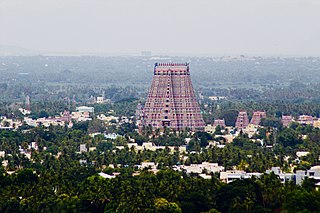
Srirangam also known as Thiruvarangam, is a neighbourhood of the city of Tiruchirappalli and a part of Tiruchirappalli Metropolitan Area in the Indian state of Tamil Nadu. A river island, Srirangam is bounded by the Kaveri River on one side and its distributary Kollidam on the other side. Considered as the first among the 108 Divya Desams, Srirangam is home to a significant population of Sri Vaishnavites.

Mariamman, also known as Marikamba, is the South Indian Hindu Goddess of rain. She is the South Indian Mother Goddess, predominant in the rural areas of Tamil Nadu and Karnataka. Mariamman is also closely related to the Hindu Goddesses Parvati and Durga as well as with her North Indian counterpart Shitala Devi.

Kapaleeshwarar Temple is a Hindu temple dedicated to lord Shiva located in Mylapore, Chennai in the Indian state of Tamil Nadu. The form of Shiva's consort Parvati worshipped at this temple is called Karpagambal is from Tamil. The temple was built around the 7th century CE and is an example of Dravidian architecture.

'Thottiyam is a panchayat town in Tiruchirappalli district in the Indian state of Tamil Nadu. Thamilselvi Thirugnanam is the current President of Thottiyam. It is situated 60 km north-west of Tiruchirapalli on Tiruchy-Namakkal State Highway (SH-25) and further it connects Namakkal-Salem-Bangalore National Highway. It is located near the Kaveri River, about 12 km north-west of Musiri.The name of the town is said to derive from the Thottiya Nayakar caste peoples living there. But people of SozhiyaVellalar Mutharaiyar community was majority and have ruling efficiency in Thottiyam Koranganatha Temple located in the outskirts of the town is a historic temple built during the Chola period in the 10th century.

Temple cars are chariots that are used to carry representations of Hindu gods. The car is usually used on festival days, when many people pull the cart.

Saidapet, also known as Saidai, is a neighbourhood in Chennai, India, situated in the northern banks of the Adyar River and serves as an entry point to Central Chennai. It is surrounded by West Mambalam in the North, C.I.T Nagar in the North-East, Nandanam in the East, Guindy in the South, Jafferkhanpet and Ashok Nagar in the North-West. The Saidapet Court, the only other court of judicature in Chennai city apart from the Madras High Court, and the Saidapet bus depot are located here. Prior to its incorporation in Madras city, Saidapet functioned as the administrative headquarters of Chingleput district. The neighbourhood is served by Saidapet railway station of the Chennai Suburban Railway Network.
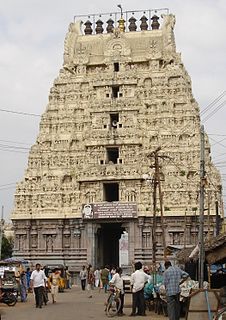
The Kamakshi Temple is an ancient Hindu Temple dedicated to Kamakshi, the ultimate form of Goddess Lalitha Maha Tripurasundari. It is located in the historic city of Kanchipuram, near Chennai, India. The Meenakshi Temple in Madurai, the Akilandeswari temple in Thiruvanaikaval near Tiruchirappalli and this Kamakshi temple are the important centers of worship of Goddess, in the state of Tamil Nadu. The Temple was most probably built by the Pallava kings, whose capital was Kanchipuram.

Namagiripettai is a panchayat town in Namakkal district in the Indian state of Tamil Nadu. 5 km from it is home to the Thulukka Soodamani Ammam at R. Puduppatti.

The Sri Mahamariamman Temple(Tamil:ஸ்ரீ மகாமாரியம்மன் திருக்கோவில்,கோலாலம்பூர்) is the oldest Hindu temple in Kuala Lumpur, Malaysia. Founded in 1873, it is situated at the edge of Chinatown in Jalan Bandar. In 1968, a new structure was built, featuring the ornate 'Raja Gopuram' tower in the style of South Indian temples.

Built in 1833, the Arulmigu Sri Mahamariamman Temple in George Town is the oldest Hindu temple in Penang, Malaysia, and features sculptures of gods and goddesses over its main entrance and facade. It is located at Queen Street, George Town.

The Thimithi or firewalking ceremony is a Hindu festival originating in Tamil Nadu, South India that is celebrated a week before Deepavali, during the month of Aipasi of the Tamil calendar. The fire-walking ceremony is in honour of the goddess Draupati Amman, who is considered the incarnation of goddess Mariamman, and is practiced not only in India, but also in Fiji, Sri Lanka, Singapore, Malaysia, Mauritius, Réunion, South Africa and other countries with large South Indian populations.

Azhagiya Manavalan Perumal Temple in Uraiyur, a suburb Tiruchirappalli in the South Indian state of Tamil Nadu, is dedicated to the Hindu god Vishnu. Constructed in the Dravidian style of architecture, the temple is glorified in the Divya Prabandha, the early medieval Tamil canon of the Alvar saints from the 6th–9th centuries AD. It is one of the 108 Divyadesam dedicated to Vishnu, who is worshipped as Azhagiya Manavalan and his consort Lakshmi as Kamalavalli.

Bannari Amman temple is one of the most famous Amman temples in Tamil nadu and it is in Bannari on NH 209, near Sathyamangalam, Erode district. Main deity is goddess Mariamman, a powerful goddess from the Tamil and Kannada folklore. Roughly Every village in the Kongu region of Tamil Nadu has a Mariamman temple.
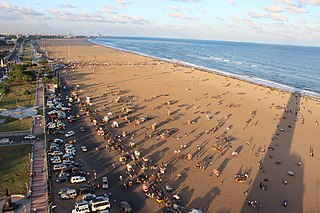
Tamil Nadu has the largest tourism industry in India with an annual growth rate of 16%. In 2015, the number of domestic arrivals was at 333.5 million making the state the most popular tourist destination in the country, and foreign arrivals numbered 4.68 million, the highest in the country, making it the most popular state for tourism in the country.
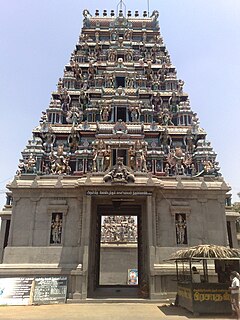
Kondathu Kaliamman Temple is an Amman temple located at Pariyur near Gobichettipalayam in Tamil Nadu, India. There are other temples, namely Sri Amarapaneeswarar Temple, Sri Adinarayana Perumal Temple and Sri Angalamman Temple nearby.
The flower festival or flower sprinkling festival is an important festival celebrated in the Samayapuram Mariamman temple near Tiruchirappalli, India. This festival is usually held in the Tamil month of Masi. During this festival, devotees throng the temple to sprinkle flowers on the idol of the Hindu goddess Mariamman. During this period, it is believed, that the goddess fasts for the welfare of her devotees for a period of 28 days. As a result, the ritual consecration of food at the temple does not take place.

Covering an area around Queen Street, Chulia Street and Market Street, Little India in the city of George Town in Malaysia, is an ethnic Indian enclave. The oldest Hindu temple in Penang, Sri Mahamariamman Temple is located here. This area bears many similarities to market streets in Chennai, Mumbai or Delhi. Its location at the centre of Penang Heritage Zone and nearby Penang's main finance centre, Beach Street make it one of the most famous and notable shopping spot in Penang among local and tourist. Little India is also famous for Malaysian Indian cuisine. It also serves as main commercial and cultural activities of Penang Indians. The place becomes more lively during festival times like Deepavali, Christmas and Thaipusam.
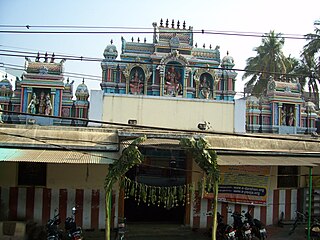
Vekkali Amman Temple is a temple dedicated to the Goddess Vekkaali, a form of the goddess Kali. It is located in Woraiyur, a neighbourhood in Tiruchirappalli, Tamil Nadu, India. The central shrine of the temple houses the image of Vekkali Amman and the major feature of the temple is the absence of roof over the sanctum. The temple is known from the period of early Cholas, but there are no historical records. The people of Woraiyur see Vekkali Amman as their guardian deity. The temple has six daily rituals in its calendar and celebrates six annual festivals. The temple chariot is made of gold and was launched during 2010. The temple is maintained and administered by the Hindu Religious and Endowment Board of the Government of Tamil Nadu.

The Balathandayuthapani Temple, officially the Arulmigu Balathandayuthapani Kovil, better known as the Waterfall Hill Temple or "Thaneer Malai" by locals, is a temple complex located in George Town, Penang. The main deity of this temple is Murugan. Visitors need to climb 513 stairs to reach the temple. It is the focal point of the Hindu festival of Thaipusam in Malaysia, after the Batu Caves. The hilltop temple, with its seven-storey 21.6m-tall gopuram, has been touted as the largest Lord Murugan temple outside India.
The Hindu Mahajana Sangam is an association of Indian workers. It is one of the Indian non-profitable organization at Penang, Malaysia which has been officially established in 1935 by waterfronts workers. Before 1935, it known as Kootakkadai .




















